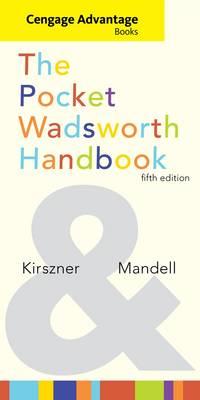Overview
This fifth edition of The Pocket Wadsworth Handbook provides up-to-date, realistic advice for today's digital-age students. You will find it clearly written, thorough, easy to navigate, and indispensable for use in college courses and beyond.
Full Product Details
Author: Stephen R. Mandell ,
Laurie G. Kirszner
Publisher: Cengage Learning, Inc
Imprint: Heinle
Edition: 5th Revised edition
Dimensions:
Width: 13.20cm
, Height: 2.00cm
, Length: 21.60cm
Weight: 0.334kg
ISBN: 9780495912958
ISBN 10: 0495912956
Pages: 416
Publication Date: 01 January 2011
Audience:
Adult education
,
Further / Higher Education
Format: Spiral bound
Publisher's Status: Out of Print
Availability: In Print

Limited stock is available. It will be ordered for you and shipped pending supplier's limited stock.
Reviews
How to Use This Book. Part I: WRITING ESSAYS AND PARAGRAPHS. 1. Understanding Purpose and Audience. 2. Writing Essays. 3. Writing Paragraphs. 4. Writing an Argumentative Essay. Part II: WRITING GRAMMATICAL SENTENCES. 5. Revising Run-ons. 6. Revising Sentence Fragments. 7. Understanding Agreement. 8. Using Verbs. 9. Using Pronouns. 10. Using Adjectives and Adverbs. Part III: WRITING EFFECTIVE SENTENCES. 11. Writing Varied Sentences. 12. Writing Concise Sentences. 13. Revising Awkward or Confusing Sentences. 14. Using Parallelism. 15. Placing Modifiers Carefully. 16. Choosing Words. Part IV: UNDERSTANDING PUNCTUATION. 17. Using End Punctuation. 18. Using Commas. 19. Using Semicolons. 20. Using Apostrophes. 21. Using Quotation Marks. 22. Using Other Punctuation Marks. Part V: UNDERSTANDING SPELLING AND MECHANICS. 23. Becoming a Better Speller. 24. Knowing When to Capitalize. 25. Using Italics. 26. Using Hyphens. 27. Using Abbreviations. 28. Using Numbers. Part VI: WRITING WITH SOURCES. 29. Writing Research Papers. 30. Using and Evaluating Library Sources. 31. Using and Evaluating Internet Sources. 32. Integrating Source Material into Your Writing. 33. Avoiding Plagiarism. Part VII: DOCUMENTING SOURCES: MLA STYLE. 34. MLA Documentation Style. Part VIII: DOCUMENTING SOURCES: APA AND OTHER STYLES. 35. APA Documentation Style. 36. Chicago Documentation Style. 37. CSE and Other Documentation Styles. Part IX: DEVELOPING STRATEGIES FOR ACADEMIC SUCCESS. 38. Ten Habits of Successful Students. 39. Reading Critically. 40. Designing Effective Documents. 41. Writing in a Digital Environment. (new chapter) 42. Writing for the Workplace. 43. Making Oral Presentations. 44. Writing in the Disciplines. (new chapter) Part X: RESOURCES FOR BILINGUAL AND ESL WRITERS. 45. Adjusting to the US Classroom. 46. Grammar and Style for ESL Writers. Appendix A: Grammar Review. Appendix B: Usage Review. Credits. Index. Correction Symbols.
This handbook provides a concise yet comprehensive approach to the various aspects of writing and the writing process. The use of student writing samples is very helpful, as well as the section on reading critically. The size and visual nature of the text is very appealing and user friendly. The organization is very clear and logical. This text strikes a wonderful balance between whetting the appetite for a topic while allowing the instructor flexibility to cater the rest of the discussion to the student's specific needs.
Author Information
Stephen R. Mandell is a bestselling author and a practicing teacher who is well known nationally. Mandell, together with coauthor Laurie G. Kirszner, has written bestsellers for nearly every English market. They have the deepest publishing record of any handbook author team and have successfully published up and down the curriculum from developmental to literature. Laurie G. Kirszner is a bestselling author and a practicing teacher who is well known nationally. Kirszner, together with coauthor Stephen R. Mandell, has written bestsellers for nearly every English market. They have the deepest publishing record of any handbook author team and have successfully published up and down the curriculum from developmental to literature.




